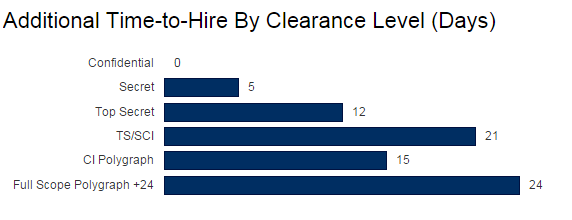What are current trends in time-to-hire? Many signs point to stormy skies when it comes to cleared hiring, particularly for the unprepared. The size of the cleared workforce continues to drop. New security clearances and Periodic Reinvestigations (PRs) are taking longer to process, thanks to changes at OPM.
Cleared professionals and STEM positions have traditionally faced longer time-to-hire. A 2014 Brookings Institute study found time-to-hire for STEM positions requiring a professional degree averaged 50 days, compared to 33 days for non-STEM vacancies. Within STEM vacancies, computer skills were associated with the highest salaries and longest advertisement durations, according to the Brookings study.
When it comes to cleared STEM professionals, the time-to-hire figure increases even more.
“In general, we’ve seen that the higher the security clearance, the longer the time it takes to hire,” said Evan Lesser, founder and Managing Director of ClearanceJobs.com.
OPM’s Investigation Woes
OPM faced serious changes in 2014. The largest contract background investigation firm was sued by the Department of Justice, allegedly hacked by China, and eventually all existing investigations were transferred to other companies. An Office of Management and Budget interagency report following the Navy Yard Shooting called for desk audits of all cleared professionals and a ten percent reduction in the size of the cleared workforce. It also introduced a pilot of continuous monitoring, which was then rolled out progressively to more cleared workers.
New scrutiny of all cleared professionals, longer investigation times, and a smaller pool of candidates to choose from al create a strain on the workforce. New changes to interim clearances make obtaining a new clearance more difficult, increasing the value of a clearance.
Cleared Compensation on the Rise
For the first time in several years, cleared professionals feel optimistic about their chances for a pay raise. A recent survey of nearly 700 cleared professionals showed that more than 70 percent expect a pay increase in the coming year.
Making the Best of a Competitive Market
All of these factors could be bad news for recruiters, who already cite increased competition and a lack of qualified candidates as two of their biggest recruiting hurdles.
Time-to-hire was already on the rise at the end of 2014, said Gary Goss, recruiting manager at ProSol. He expects time-to-hire in 2015 to mirror that, particularly due to the government’s push for ‘Lowest Price, Technically Acceptable’ (LPTA) contracts. The push for lower prices means many companies are now offering lower salaries. The number of qualified applicants also impacts time-to-hire. In many cases, recruiters are all vying for the same candidates in a small talent pool. In other cases, the talent pool is larger, and ‘we are looking for a specific needle in a haystack; adding to the time-to-hire,’ said Goss.
To reduce time-to-hire and put candidates to work faster, Goss notes they employ an ‘active bench of candidates.’ When they find a perfect candidate, they also try to place them elsewhere in the company, if the ideal spot isn’t open. When it comes to attracting great talent, time is critical.
“In our industry we will have many challenges this year, both with the DoD Budget in limbo and the increased difficulty with getting candidates cleared,” said Luke Mann, Staffing Operations Lead with Northrop Grumman Technical Services.
Despite the clear recruiting challenges, Mann expects his time-to-hire to decrease in 2015. At Northrop Grumman, they know where the biggest ‘lag time’ is in their hiring process, said Mann. To prevent hang-ups in the process, they have a clear process for moving candidates quickly through those stages. He also sites ‘constant communication and expectation setting with your candidates’ as critically important.
To decrease your time-to-hire in and get the best candidates to work faster, here are our top tips.
1. Write Better Job Descriptions.
With more opportunities to choose from, reeling in the best candidates requires giving them insight into the work they’ll do. A 2014 ClearanceJobs survey of cybersecurity professionals showed meaningful work and being challenged were the top two things that kept them engaged on the job. If you can’t show a candidate they’ll enjoy the work, you won’t be able to make the hire.
2. Hire From Your Pipeline.
Talent pipelining or ‘relationship recruiting’ remains widely popular. If you want it to be more than a buzz word you need to put your pipeline to work when it comes time to hire. Categorize pipelined candidates by clearance level, region and industry. And be sure to keep that talent warm with regular check-ins. Hiring from an already-cleared talent pipeline can be one of the easiest ways to decrease time-to-hire, but only if you know where to look and who’s available.
3. Have a Plan in Place.
You can’t improve time-to-hire if you don’t know where you stand. Consider time-to-hire in your most competitive career categories, and figure out where the biggest slow-downs are in the process. As Mann notes, consistency is key – your whole team has to be engaged in improving the process if you want to move the needle in a significant way. Remove any obstacles you can.
4. Hire already cleared candidates.
It goes without saying that hiring already cleared candidates can significantly speed up time-to-hire. Particularly with continued efforts to reduce the size of the cleared workforce, downward pressure will continue to put a premium on already-cleared professionals, particularly those with higher level security clearances and cyber skills.

